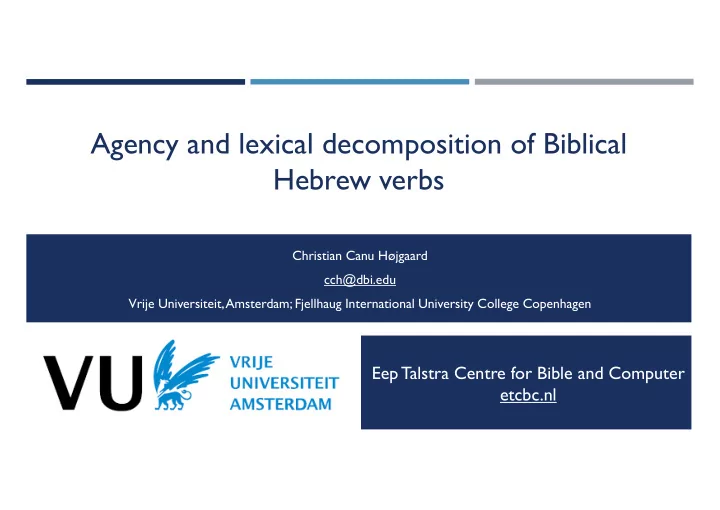

Agency and lexical decomposition of Biblical Hebrew verbs Christian Canu Højgaard cch@dbi.edu Vrije Universiteit, Amsterdam; Fjellhaug International University College Copenhagen Eep Talstra Centre for Bible and Computer etcbc.nl
AGENCY AND LEXICAL DECOMPOSITION OF BIBLICAL HEBREW VERBS Intuition is a basic requirement, e.g. (Van Valin 2005, 36): a. *The window shattered vigorously b. The house is shaking vigorously
A PROPOSAL OF APPLYING QUANTITATIVE METHODS How can we decompose verbs in ancient, “dead” languages? Applying statistical methods to distinguish active and stative verbs Applying additional qualitative criteria to distinguish causative and non- causative verbs
1. CLASSIFYING ACTIVE/STATIVE VERBS: A QUANTITATIVE APPROACH Applied method : “covarying collexeme analysis” (Gries and Stefanowitsch 2004; Stefanowitsch and Gries 2005) Purpose : T o compute how strongly a verb is associated to a certain adverb
Four construction types: Verb + adverbial Verb + any other adverbial Any other verb + adverbial Any other verb + any other adverbial Corpus = all verbs + all adverbials verb adverbial All other All other verbs adverbials
COVARYING COLLEXEME ANALYSIS Selection of four complement forms Complement form Hebrew Presumed function Preposition ”in” + substantive ב Locational Prep. ”on” + subs. לע Locational Prep ”to” + subs. לא Directional Subs. + morphological suffix - ה Directional A rough disambiguation of complements: excluding substantives likely to be used as instruments (e.g. “rock”, “stick” and body parts)
RESULTS The layout of the plot is adapted from Cody Kingham (github.com/CambridgeSemiticsLab/BH_time_collocations)
RESULTS
MOVING ON: PRINCIPAL COMPONENT ANALYSIS Purpose : To explore a number of independent, quantitative variables and reduce the variation caused by the variables to the lowest number of dimensions (”principal components”) possible.
TRANSFER VERBS Give , cf. Van Valin (2005, 61): [ do’ (Pat, Ø) CAUSE [BECOME have’ (Chris, book)] Pat gave the book to Chris
2. BROADENINGTHE SCOPE: CAUSATIVES Causative test (cf. Van Valin 2005, 38): The dog frightens the boy The dog caused to the boy to fear
SEMANTICTRANSITIVITY Hopper and Thompson (1980, 264) “… causatives are highly Transitive constructions: they must involve at least two participants, one of which is an initiator, and the other of which is totally affected and highly individuated.”
SEMANTICTRANSITIVITY Prototypical transitivity, cf. Åshild Næss (2007) Agent Patient Volitionality + – Instigation + – Affectedness – +
AFFECTEDNESS AND CAUSATION Emotion verbs ʔ îš ʔ im -mô w ᵊ ʔā v -îw tîr ā - ʔ û man mother-PRS.M.3SG CON father-PRS.M.3SG fear.IMPF-M.2PL Everyone shall fear his father and mother (Leviticus 19:3) RRG: fear’ (man, his father and mother) Actor Undergoer Næss : Volitionality + – Instigation – – Affectedness – +
AFFECTEDNESS AND CAUSATION Consumption verbs šiv ʕ at y ā m-îm mas - ṣ ôt t ōˀ x ē l -û seven day -M.PL bread-F.PL eat.IMPF-M.2PL For seven days you shall eat unleavened bread (Leviticus 23:6) RRG: do' (you, [ eat’ (bread)]) Actor Undergoer Næss : Volitionality + – Instigation + – Affectedness + +
AFFECTEDNESS AND CAUSATION Construction verbs û n ṭ a ʕ -tem kol ʕēṣ ma ˀᵃ x ā l CON plant.PERF -M.2PL any tree eat … and you plant any fruit tree (Leviticus 19:23) RRG : do’ (you, [ plant’ (any fruit tree)]) Actor Undergoer Næss : Volitionality + – Instigation + – Affectedness – –
AFFECTEDNESS AND CAUSATION Existential verbs w ᵊ l ōˀ t ᵊ - ḥ all ē l ʔ et š ē m ʔᵉ l ō he ʸ -x ā CON NEG M.2SG-defile.IMPF OBJ name God -PRS.M.2SG and you may not defile the name of your God (Leviticus 18:21) RRG : [Do’ (you, Ø)] CAUSE [BECOME unclean’ (the name of your God)] Actor Undergoer Næss : Volitionality + – Instigation + – Affectedness – +
AFFECTEDNESS AND CAUSATION Transfer verbs h ā ʔā re ṣ ʔᵃ šer ʔᵃ nî n ō t ē n l ā -xem DET land REL I give.PTC to-PRS.M.2PL the land which I am giving to you (Leviticus 25:2) RRG : [ Do’ (I, Ø)] CAUSE [BECOME have’ (you, the land)] Actor Undergoer Næss : Volitionality + + Instigation + – Affectedness – +
IN CONCLUSION Covarying collexeme analysis can be succesfully applied to an ancient corpus to distinguish active and stative a. verbs. More fine-grained parameters will likely increase the accuracy (but reduce the number of relevant constructions…) Affectedness serves as a useful category to distinguish causative and non-causative verbs. b.
All codes, datasets, and plots on github.com/ch-jensen/semantic-roles Thank you for your attention! Christian Canu Højgaard cch@dbi.edu Vrije Universiteit, Amsterdam; Fjellhaug International University College Copenhagen
Recommend
More recommend